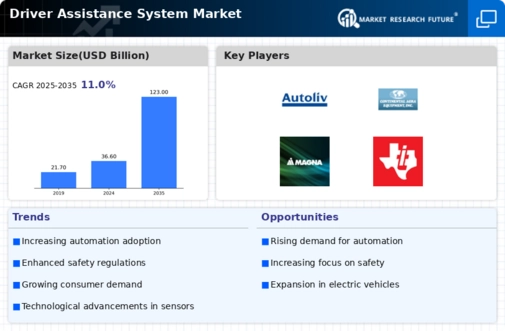Top Industry Leaders in the Driver Assistance System Market

The Competitive Landscape of the Driver Assistance System Market
The journey towards autonomous vehicles is paved with the ever-evolving Driver Assistance System (DAS) market. This industry, witnesses established giants and agile innovators competing to make driving safer, smoother, and more enjoyable. Let's buckle up and explore the key strategies, players, and dynamics shaping this critical domain.
Some of the Driver Assistance System companies listed below:
- Gentex Corporation
- Delphi Automotive Plc
- Autoliv Inc.
- Hitachi Ltd
- Continental AG
- Magna International
- Hella Kgaa Hueck & Co.
- Robert Bosch Gmbh
- Texas Instruments Inc.
- Renesas Electronics Corporation
Strategies Adopted by Leaders
- Technological Innovation: Continuous development drives the market, with companies aggressively investing in research and development to enhance existing DAS features and introduce new functionalities like Automated Emergency Braking (AEB) and Traffic Jam Assist (TJA). Advanced sensor technologies, AI-powered algorithms, and cloud-based data analytics are key differentiators in this rapidly evolving sector.
- Focus on Levels of Automation: Recognizing the varying degrees of driver assistance, established players like Bosch diversify their offerings, targeting features from Level 1 (basic assistance) to Level 2 (partial automation) and beyond. Niche players like Mobileye specialize in advanced vision systems that pave the way for higher levels of autonomous driving.
- Partnerships and Collaboration: Building partnerships with vehicle manufacturers, technology providers, and regulatory bodies becomes crucial. Collaborations accelerate technology development, ensure compatibility across systems, and address regulatory requirements for widespread DAS adoption.
- Focus on Affordability and Accessibility: Making DAS features accessible to a wider range of consumers requires cost-effective solutions. Companies like NXP Semiconductors develop affordable sensor technologies and software platforms, democratizing driver assistance across different vehicle segments.
Critical Factors for Market Share Analysis
- Unit Shipments: Quantifies the number of DAS-equipped vehicles sold, particularly relevant for Tier 1 suppliers serving major automakers.
- Technological Advancements: Leading the way in areas like AI-powered vision systems, LiDAR integration, or V2X communication can significantly influence market share in the long run.
- Brand Reputation and Consumer Trust: Established brands like Bosch and Continental often hold an edge due to their well-known track record in safety and reliability.
- Regulatory Landscape: Understanding regional regulations and compliance requirements, such as the NCAP safety ratings in Europe, helps predict market demand for specific DAS features.
New and Emerging Companies:
Beyond established players, the DAS market is abuzz with innovative startups offering disruptive solutions. Notable examples include:
- ArduPilot: Develops open-source autopilot platforms for drones and self-driving vehicles, fostering community-driven innovation and cost-effective solutions.
- Comma.ai: Offers aftermarket retrofitting kits for existing cars, bringing advanced ADAS features within reach of budget-conscious consumers.
- Cruise Automation: Operates fleets of robotaxis in select cities, pushing the boundaries of autonomous driving and providing valuable real-world data for future iterations.
These agile startups inject fresh ideas and challenge traditional paradigms, keeping the DAS landscape dynamic and exciting.
Industry Developments:
September 2023- Denza, a leading name in Chinese premium EV lately revealed a cost-effective version of its latest ADAS (advanced driver assistance system) in association with Nvidia, US chipmaker, as the BYD affiliate is ramping up efforts in competing against top self-driving players like Huawei and Xpend Motors.
Denza is eyeing overseas expansion as well, having made its presence within the China market of about 80,000 EVs with year-to-date deliveries as of this August. The company is predicting overseas sales to start by next year earliest including Europe, the Middle East, Southeast Asia, and Australia.
The companies stated the launch of such cost-effective assisted driving technology will cut down the barrier to a shift to intelligent mobility. This system facilitates the vehicles of Denza to navigate maximum number of highways in China along with few busy urban streets in key domestic cities.
This novel autonomous driving system in fact will allow on-ramp to off-ramp driving along with automatic lane changing particularly on Chinese highways for the company’s flagship N7 SUV. This has a price of RMB 15,000 and is powered via DRIVE Orin processor of Nvidia that can handle about 84 TOPS. N7 SUVs which has this technology will get 2 lidar sensors removed for cutting down on cost.
The companies stated that the higher-end model which costs RMB 23,000 will enable cars to function via themselves for daily commute on the bustling city streets using a feature called City NOA. The company is likely to release their Highway NOA to N7 owners beginning in December 2023.
